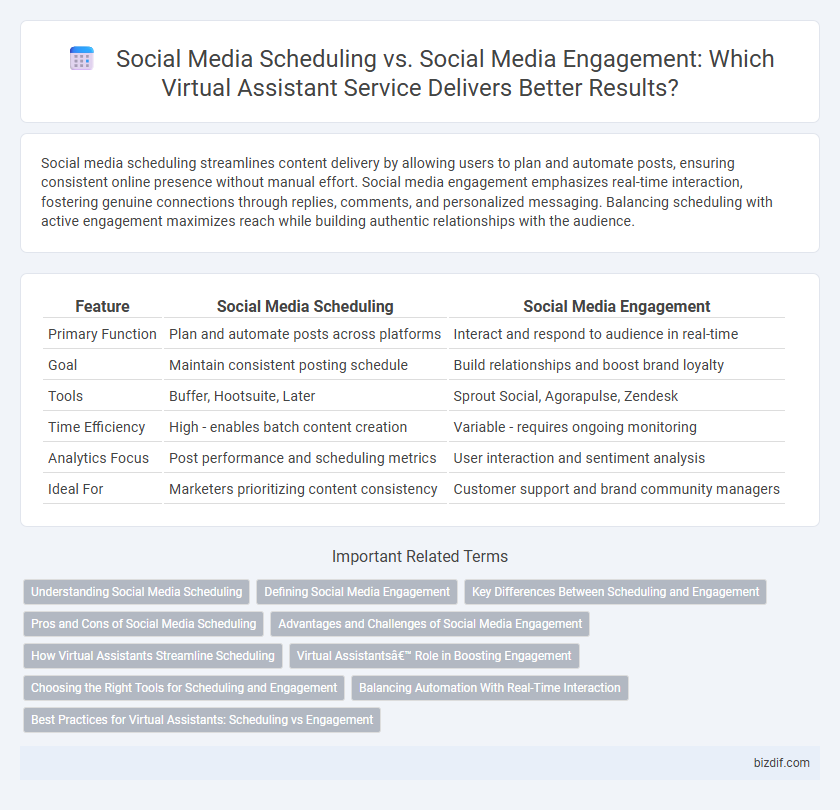Social media scheduling streamlines content delivery by allowing users to plan and automate posts, ensuring consistent online presence without manual effort. Social media engagement emphasizes real-time interaction, fostering genuine connections through replies, comments, and personalized messaging. Balancing scheduling with active engagement maximizes reach while building authentic relationships with the audience.
Table of Comparison
| Feature | Social Media Scheduling | Social Media Engagement |
|---|---|---|
| Primary Function | Plan and automate posts across platforms | Interact and respond to audience in real-time |
| Goal | Maintain consistent posting schedule | Build relationships and boost brand loyalty |
| Tools | Buffer, Hootsuite, Later | Sprout Social, Agorapulse, Zendesk |
| Time Efficiency | High - enables batch content creation | Variable - requires ongoing monitoring |
| Analytics Focus | Post performance and scheduling metrics | User interaction and sentiment analysis |
| Ideal For | Marketers prioritizing content consistency | Customer support and brand community managers |
Understanding Social Media Scheduling
Social media scheduling involves planning and automating posts across platforms like Facebook, Instagram, and Twitter, enabling consistent content delivery and time management for brands. It enhances efficiency by allowing marketers to pre-set publishing times based on audience peak activity periods, boosting reach and visibility. Understanding scheduling tools such as Hootsuite or Buffer is crucial for maximizing social media strategy and freeing resources to prioritize real-time social media engagement.
Defining Social Media Engagement
Social media engagement refers to the interactions users have with content on platforms, including likes, comments, shares, and direct messages, which measure the effectiveness of audience connection and brand impact. Unlike social media scheduling, which automates the timing and posting of content, engagement focuses on real-time communication and building community relationships. High engagement rates indicate strong audience interest and contribute to improved algorithmic ranking and organic reach across platforms like Facebook, Instagram, Twitter, and LinkedIn.
Key Differences Between Scheduling and Engagement
Social media scheduling automates content posting by allowing users to plan and publish posts at predetermined times, ensuring consistent online presence without manual intervention. In contrast, social media engagement involves real-time interactions such as responding to comments, messages, and fostering community conversations to build relationships and brand loyalty. The key difference lies in scheduling's focus on content delivery efficiency, while engagement prioritizes active user interaction and personalized communication.
Pros and Cons of Social Media Scheduling
Social media scheduling offers the advantage of consistent content posting, saving time and ensuring a steady online presence, but it can lack the spontaneity that drives authentic engagement. Automated scheduling tools enable planning posts in advance, which helps maintain a content calendar and optimize posting times for audience reach. However, reliance on scheduling may reduce real-time interaction, potentially missing immediate responses to trending topics or audience feedback.
Advantages and Challenges of Social Media Engagement
Social media engagement offers the advantage of building authentic connections by fostering real-time interactions, boosting brand loyalty and customer trust. However, challenges include the need for consistent, timely responses and managing negative feedback, which require dedicated resources and strategic communication skills. Unlike scheduling tools that automate posting, engagement demands active participation to effectively enhance community growth and brand reputation.
How Virtual Assistants Streamline Scheduling
Virtual assistants streamline social media scheduling by automating content posting across multiple platforms, ensuring consistent and timely updates without manual intervention. This automation frees up time for businesses to focus on social media engagement, such as responding to comments and fostering community interaction. By integrating scheduling tools with analytics, virtual assistants optimize posting times to maximize reach and user interaction.
Virtual Assistants’ Role in Boosting Engagement
Virtual assistants streamline social media scheduling by automating post timing and content distribution, ensuring consistent online presence. Their proactive engagement tactics, such as responding to comments and messages promptly, foster stronger community connections. By balancing efficient scheduling with genuine interaction, virtual assistants significantly boost overall social media engagement rates.
Choosing the Right Tools for Scheduling and Engagement
Selecting the right social media tools involves balancing scheduling capabilities with engagement features to maximize efficiency and audience interaction. Platforms like Hootsuite and Buffer excel in scheduling posts across multiple channels, while tools such as Sprout Social and Agorapulse offer robust engagement options, including real-time message tracking and response management. Prioritizing a tool that integrates seamless scheduling with proactive engagement boosts brand presence and drives meaningful community connections.
Balancing Automation With Real-Time Interaction
Effective social media management requires balancing scheduling tools with active engagement to maximize reach and foster genuine connections. Automation streamlines content posting across platforms like Instagram, Twitter, and Facebook, ensuring consistent visibility while freeing time for real-time interactions that boost audience trust and responsiveness. Integrating AI-driven scheduling with personalized replies enhances brand authenticity and optimizes user experience in dynamic digital environments.
Best Practices for Virtual Assistants: Scheduling vs Engagement
Virtual assistants maximize social media impact by balancing scheduling and engagement, using tools like Hootsuite or Buffer to automate posts while monitoring real-time interactions for personalized responses. Effective scheduling ensures consistent brand presence, while prompt engagement fosters community growth and trust, leveraging analytics to refine timing and content strategies. Prioritizing both practices enhances audience reach and strengthens client relationships through strategic post planning and active communication.
Social media scheduling vs Social media engagement Infographic

 bizdif.com
bizdif.com